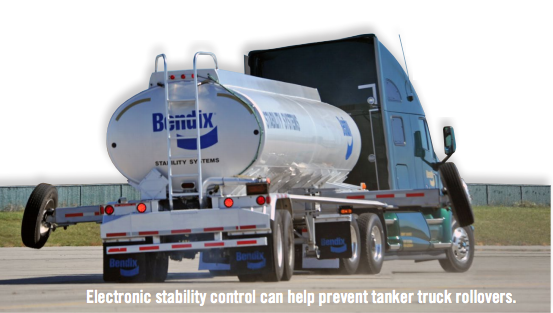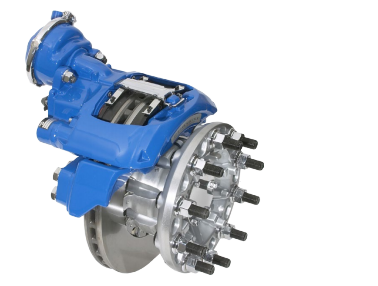FOR TANKER FLEETS, TECHNOLOGIES ARE AVAILABLE TO ADDRESS ALMOST EVERY TYPE OF ACCIDENT. BUT SOMETIMES IT’S THE SIMPLEST SOLUTIONS THAT WORK BEST.
BY JAMES MENZIES
Rollovers, jackknifes, and rear-end collisions: these are what nightmares are made of for tanker fleet operators. Fortunately, safety technologies have arrived on the scene that address most of the common causes of collisions. But some work better than others.
Jade Transport now spec’s all of its trucks and trailers with disc brakes, which can shorten stopping distances and provide better braking performance. The spec’ is becoming more common, as several truck OEMs have standardized discs. But not everyone is convinced the performance advantage is worth the cost of investment.

Fleets divided on discs
Gino Mella, co-owner of Milton, Ont.-based G&D Tank Repair, points out the cost of a brake job is about triple for discs compared to drums, even though brake jobs are required less frequently. And they also cost more to purchase.
“Smaller fleets are not leaning towards disc brake applications because of the cost issue and they feel drum brakes, as long as the drivers are keeping that ( following) distance on the road, are sufficient to do the job,” Mella explained. Besnik Gasi, area manager for Trimac, agrees with that assessment.
“Disc brakes offer excellent braking control,” he acknowledges, but he adds “our drivers prefer drums.”
Maintenance intervals on drum brakes are easier to predict, Gasi adds, and Trimac failed to see a reduction in its total cost of ownership when running disc brakes on a portion of the fleet. Drivers, meanwhile, reported drum brakes performed better on downhill grades.
While the jury is still out on air disc brakes, fleets we spoke to agree that a focus on driver behavior can help prevent crashes, and more are utilizing video to do this. Jade Transport puts new drivers through an extensive orientation, which includes the required viewing of safety videos.
“You get a pretty good grip on a guy by the time he’s done orientation,” says Sheldon Jonasson, driver services, safety and training manager with Jade Transport. “We go through close to five days of training here. Then we send them with a driver to cover product handling.”
Trimac has begun installing in-cab cameras to monitor driver behavior, and uses the videos generated on-highway for coaching. Gasi said the company tried three in-cab camera platforms before deciding on the DriveCam by Lytx system.
“It protects drivers from false accusations,” he says. “The commercial driver is always at fault until proven innocent. We also saw it as a personal coaching benefit. If we have a bad hire, someone who drives aggressively, I don’t need the DriveCam to tell me that. My onboard computers will detect lane departures, following distance, hard braking, and speeding. We want to focus on the people that were not bad hires – that are professional drivers – but how do we provide coaching to them?”
Traditional methods of calling them in for a safety meeting or doing a ride-along a couple of times a year are no longer sufficient, Gasi explains.
“Here is a system that will give you feedback immediately, and give us an opportunity to recognize drivers when they were in a near-collision (that they avoided),” he says.
In-cab cameras identify risky drivers
Trimac has recognized drivers who have prevented collisions through skilled driving. Jade Transport is still considering deploying in-cab cameras. Other fleets are opting for collision mitigation systems, which can detect potential crash events and then apply the brakes to prevent them – or to reduce the severity of the impact. These systems, available from all truck OEMs, use cameras, radar, or a combination thereof, to monitor following distances, lane-keeping, and even adherence with speed limits.
But Gasi says he doesn’t feel the technology is yet ready for primetime, and prefers relying on in-cab cameras.
“We are waiting for the technology to work better,” he says of today’s collision mitigation systems. “We have had false positive brake events that could’ve been very dramatic.”
In one instance, he recalls, a team driver was thrown from the bunk when the truck applied the brakes after it interpreted a shadow as an object it needed to avoid. That type of experience can leave a lasting sense of apprehension for any fleet manager or driver.
“I know the systems coming out today are better than the systems from a few years ago,” he acknowledges. “Do we have them? Yes. Are they perfect? Not yet.”
He is, however, a big fan of stability control systems, and was an early adopter of the technology. He says even professional, experienced drivers, can benefit from stability control. Spec’ing stability control has nearly eliminated rollovers at Trimac.
“Rollovers always start at the back, and once that occurs, there’s no recovering from it,” he says.
Trimac tested stability control on a truck operated by an experienced professional on a dedicated run. There was an S-curve on the route, which the driver handled for years without incident. When the stability system was deployed, it intervened on numerous occasions, suggesting the driver was taking the curves at a mere 2-3 mph below the rollover threshold.
“That was justification for me,” Gasi recalls. “There was no margin for error.”
Jonasson points out some low-tech options can also go a long way towards improving fleet safety. Jade’s tractor-trailers are known for their cleanliness – and that’s not just so they look good going down the highway.
“When you have nice, clean equipment, it’s easier to see stuff like minor cracks. Guys don’t mind getting a little closer to the truck if they’re not getting covered with dirt all the time,” he says. “All our trucks are hand washed. They’ll brush the axles, but the trucks themselves are all hand washed.”
Mella agrees cleanliness is a vital part of any tanker fleet safety program, especially in barrel applications.
“A proper internal wash and dry every time you go in is going to cost you, maybe $100 to do a proper dry,” he points out. “In the tanker industry, water droplets can be the start of pitting in the interior of the barrels. If they’re not drying tanks properly, there can be a reaction there, it creates the onset of pitting, which gets to the point where the barrel is no good. Now you put it out of compliance because there’s too much pitting and instead of having a trailer worth $100,000, it’s now worth $30,000 because it can’t be used for HazMat.”

“When you have nice, clean equipment, it’s easier to see stuff like minor cracks. Guys don’t mind getting a little closer to the truck if they’re not getting covered with dirt all the time.”
– Sheldon Jonasson, Jade Transport
Safety in the yard and the shop

When your headquarters is in Manitoba, navigating the yard can be as hazardous for drivers as being on the road. Even when on foot. To prevent injuries in its yard, Jade Transport keeps drums of wood chips readily available to be spread on the ground.
“We sand the yard, and we’ve got all kinds of chips in drums,” says Sheldon Jonasson, driver services, safety and training manager with Jade. The company also spec’s the safest equipment it can, to reduce the risk of injury while handling product.
“We switched all hoses to lock fittings,” Jonasson says. “That prevents the hoses from coming undone while drivers are loading. And you don’t have to use straps or wires to lock it, they lock automatically.”
In the shop, reducing injuries is a matter of following clear policies and procedures, according to Gino Mella, co-owner of G&D Tank and Trailer, a Milton, Ont.-based tanker repair centre.
“Here, we micromanage all the safety aspects of the business,” he explains. “Your technicians have to come to work with a sound mind and have common sense – that’s really what it boils down to.”
Mella says today’s technicians have available to them all the tools required to do any job safely, as long as they choose to use the right equipment for the job. For example, when working under a trailer, use an axle stand to support the trailer and not a regular jack. Don’t become complacent, Mella warns.
“What’s going on more now, is you’re getting a workforce that is not focused, or not following procedures and protocols,” he says. “They’re getting complacent.”
To prevent this at G&D, the company has monthly safety meetings where all technicians are encouraged to bring up issues and concerns they’ve witnessed in the shop – without singling anyone out.
“It’s an open discussion done during break time when everybody is available and focused,” he says. “Everyone has to understand why or how to do something, so everybody has an understanding of what’s done. We keep minutes recorded and left as an open book for everyone to see. It’s sitting there in the lunchroom for everyone to look at. You have to be open with all the issues and everybody has to know about it.”
Mella would like to see more formalized training for tank technicians.
“Training is very valuable,” he says. “There is no training body that trains technicians on tanker trailers.”



Recent Comments